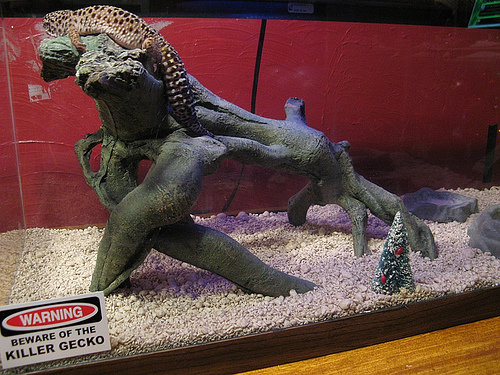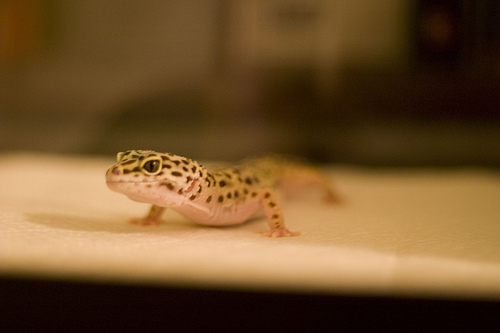
It is vital that you take the below information to heart if you want your leopard gecko to be healthy and live a long life. Despite what you might think they really are not that hard to take care of. There are number of key factors that decide how safe and happy your gecko lives though. I have spent about 2 hours researching everything you need to know when caring for your gecko. Not to mention I actually own 4 leopard geckos myself.
This leopard gecko care sheet will teach you everything you need to know about owning a leopard gecko. Lizards make wonderful pets and a leopard gecko may be perfect for you if you want a pet without having to give them a ton of attention that a cat or dog would need. Out of all the lizards the leopard gecko is probably the easiest one to take care of. Don’t worry they are completely docile and won’t bite you. Even if they did as a juvenile or even an adult it wouldn’t hurt. They are a starter lizard. When you buy a leopard gecko you need to keep a number of things in mind. In this full leopard gecko care sheet article I hope to cover a number of topics which future leopard gecko owners need to know.
Housing

As a general rule of thumb, you want your leopard gecko to have a 10 gallon tank per gecko. So if you had 5 geckos you would need a 50 gallon tank. Bare in mind that you can’t house two male leopard geckos together because they will fight. Females can be housed together. For the most part they should all get along if they each have plenty of space and hides to sleep in.
Leopard geckos are burrowers by nature need to sleep in their hide during the day. Once, the lights go out your gecko should come out and eat. Don’t be alarmed if you don’t see your gecko the first month or so. It stresses them out in a new living environment and they are very skittish at first.
Decorations
Make sure you have a background with rocks or something in the desert to make them feel comfortable. Often they will try to climb the rocks not knowing that they are just a backdrop. Decorate your cage with artificial leafs. There are tons of things you can decorate your leopard geckos tank with at your local pet store.
Make sure you have a lid on your tank even though Leopard geckos can not climb walls like tokay, day geckos, or crested geckos. It’s better to be safe than sorry, though.
Heated Rocks or Pads

It is not required that you provide your leopard gecko with a heated rock or heating pad, but it’s recommended. Leopard geckos are cold blooded reptiles and absorb the heat from their bellies. Rather than a basking lizard (such as a bearded dragon) they do not absorb the light from their heads.
I prefer heated rocks over heat pads because geckos like a little rocks they can sit on and let their food digest. Just make sure you check the heated rock or pad every couple months to make sure it hasn’t stopped producing heat.
Substrate

For baby leopard geckos I recommend that you use paper towels for the first two weeks. These reptiles are nocturnal so if you see poop they’re eating. After a couple weeks pass you can use reptile carpet which can be found at Petco or your local exotic reptile shop (recommended until they reach 20 grams). Don’t believe what the people at Petco tell you about using calcium sand for your leopard geckos because this can cause impaction. The people at Petco and Petsmart don’t know beans! You can use sands once they get older; I have written an article on this (read more here). Trust me on this one!
You can also use flooring tile which you can buy a couple of slabs of at home depot for a couple of dollars. You can get creative with tile, and it’s real easy to take out to clean when it gets dirty. Don’t use pebbles or rocks because your leopard gecko could accidentally eat it, which would cause impaction and probably end up killing your leopard gecko.
For adult leopard geckos that are over 20 grams I use play sand that you can get at Home Depot or Walmart for $4 per 50 pounds. As a general rule with the sand for every gallon of tank space you need a pound of sand. So if you have a 30 gallon tank put 30 pounds of sand in it. The cool thing about leopard geckos is they poop in the same spot so all you have to do is scoop it out every couple days and flush it down the toilet.
Hides

The more the better, but I would recommend having 3 hides per gecko. You can get away with two, but give them various kinds of shelter to hide in. One on the warm side and one on the cool side. The other can just be in the middle. Make sure they have rocks, hammocks (Sly) my oldest leopard gecko loves to sit there 24/7. Leopard geckos are burrowers by nature so they have to have a hide to feel safe and secure.
Half rock hides work great for geckos; they love to crawl in them and sleep. What I do is put mine up against the glass so I can see my gecko at all times. It’s a comforting feeling to look at your leopard gecko during the day while they sleep.
Lighting

Make sure you have a day and night bulb (either a red or blacklight). The day bulb should heat the tank between 75-85 degrees. The hotter it is the more active they will be, because their bodies metabolize their food quicker. Don’t make the mistake of using a traditional bulb you get at Target or Home Depot because these don’t put off the heat they need. They do not require UVB/UVA bulbs no matter what people will try to tell you. Other reptiles such as uroymastyx and bearded dragons require that kind of lighting. I would recommend 12 hours of light and 12 hours of darkness. To make this easy for you, you can get a timer that will automatically turn on/off your lights for you.
For a night light make sure you use a reptile black light and the temperature should never drop below 70. These give off a small amount of heat which your leopard gecko will love you for.
Food

Leopard geckos need a steady diet of crickets dusted with calcium or mealworms. Mealworms are not as healthy for your leopard gecko, but make sure you dust them with calcium. On occasion you can feed your leopard geckos super worms and wax worms. Please note that wax worms contain a high amount of fat so you shouldn’t feed them to them as a staple diet (it is more like a cookie or treat for them). Once or twice a month only. Otherwise your leopard gecko can become obese and develop health problems.
For juvenile leopard geckos make sure you dust their food with calcium once per day. On average they will eat 5-10 crickets or mealworms each day. Once they grow up to 40 grams you can then give them super worms 5 times a month and will dust their staple diet once every other day. Please note that you shouldn’t go out and buy 100’s of crickets and put them in the tank because they will bite and annoy your gecko during the day.
Water
You should have a little water bowl in there at all times. Geckos like to come out and lap up the water. What I do is buy a squirt bottle and mist the cage every night before I go to sleep. Your leopard geckos will come out of their hides and start licking the rocks, glass, and their hides when you mist their terrarium. Another thing water does for the leopard gecko is raise the humidity in which they can shed their skin easily.
Crickets

Keep your crickets in a cricket keep and make sure you gut load them. You can put in cricket food or carrots and potatoes (switch out every three days). Remember that you can not feed your leopard gecko a cricket that is bigger than the size between their eyes. You don’t want your leopard gecko to choke! Crickets come in various sizes, small, medium, and large. I recommend you use Repti Bark to minimize the smell of crickets (in your cricket keep).
Mealworms
I like to feed mine mealworms because crickets chirp and it drives me up the wall (not to mention they smell awful when they die). When you buy crickets by the thousands some of them get out when you transport them to the leopard geckos tank. To house your mealworms you can buy a Rubbermaid container at Walmart for $2. Put in oatmeal (for $1; the cheap stuff) and a couple of carrots or potatoes so they have moisture to survive longer.
Note that a lot of owners prefer to give their leopard gecko’s mealworms because they don’t smell at all and most importantly don’t chirp or have to worry about a cricket jail break when you don’t put the lid back on your cricket keep.
Bought A Leopard Gecko Now What

If you have followed all the above information make sure you don’t handle your leopard gecko for 2 weeks. Juvenile ones are going to need some time to adjust to their environment. I know it sounds harsh and you’ll be excited about your new pet, but you don’t want to stress them out. You probably won’t see them much, but this is perfectly natural. Here’s what to expect when getting your first leopard gecko.
When a couple weeks passes you can put your hand in the cage with a mealworm. At first they’re going to be hesitant towards you, but in time they will realize you are not a predator. Once your leopard gecko starts coming out you can try to scoop them up. Don’t pick them up like a bird would. Instead touch their tale and have your hand in front of them so they crawl on you. Keep them on your hand inside the tank and let them” hand crawl” on your hands. This means letting them go from hand to hand. Don’t worry they will be very skittish at first, but that’s because you’re 1000x times as big as them; they are very low on the food chain.
After a couple weeks of holding them in their tank for 10-45 minutes a day you can take them out, but I would suggest getting a large box to hold them in. You don’t want to lose your leopard gecko under the stove, couch, or somewhere will you’ll never be able to reach them. It takes months but if you do this everyday your leopard gecko will become comfortable with you.
My adults are fully hand trained and just sit on my shoulder or computer desk (while I am typing this). It takes time for them to get used to you so make sure you make them feel comfortable and never pick them up by their tales. Leopard geckos drop their tails as a defensive mechanism when a predator tries to eat them. Their tail will grow back, but it won’t look the same, unfortunately.
Please do me a favor and if you found this leopard gecko care sheet helpful please like it on Facebook, or share it using any of the social media icons on this page.










